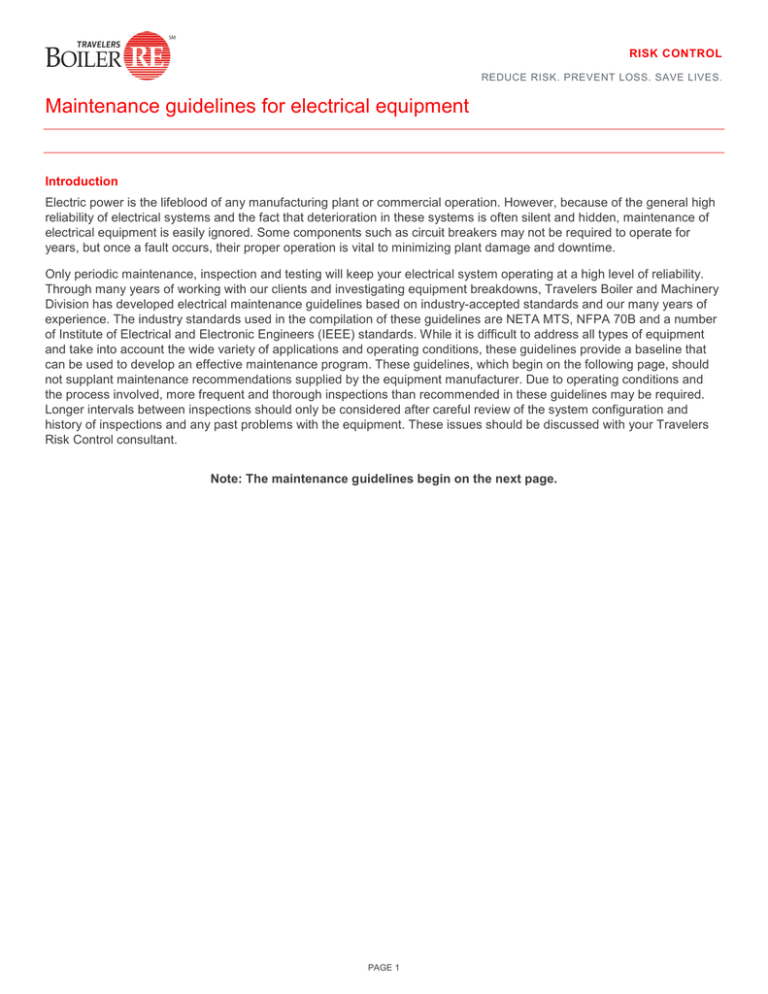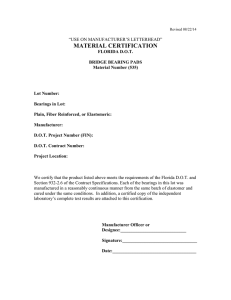
RISK CONTROL
REDUCE RISK. PREVENT LOSS. SAVE LIVES.
Maintenance guidelines for electrical equipment
Introduction
Electric power is the lifeblood of any manufacturing plant or commercial operation. However, because of the general high
reliability of electrical systems and the fact that deterioration in these systems is often silent and hidden, maintenance of
electrical equipment is easily ignored. Some components such as circuit breakers may not be required to operate for
years, but once a fault occurs, their proper operation is vital to minimizing plant damage and downtime.
Only periodic maintenance, inspection and testing will keep your electrical system operating at a high level of reliability.
Through many years of working with our clients and investigating equipment breakdowns, Travelers Boiler and Machinery
Division has developed electrical maintenance guidelines based on industry-accepted standards and our many years of
experience. The industry standards used in the compilation of these guidelines are NETA MTS, NFPA 70B and a number
of Institute of Electrical and Electronic Engineers (IEEE) standards. While it is difficult to address all types of equipment
and take into account the wide variety of applications and operating conditions, these guidelines provide a baseline that
can be used to develop an effective maintenance program. These guidelines, which begin on the following page, should
not supplant maintenance recommendations supplied by the equipment manufacturer. Due to operating conditions and
the process involved, more frequent and thorough inspections than recommended in these guidelines may be required.
Longer intervals between inspections should only be considered after careful review of the system configuration and
history of inspections and any past problems with the equipment. These issues should be discussed with your Travelers
Risk Control consultant.
Note: The maintenance guidelines begin on the next page.
PAGE 1
RISK CONTROL
Maintenance guidelines for electrical equipment
Object
Evaluation
frequency
Motors – AC
Annual
Recommendations
Check air gap clearances and adjust as needed
Inspect foundations, base plates and mounting bolts
Clean chamber and change oil on ring lubricated sleeve bearings
Sample and test oil annually on forced lubrication sleeve bearings
Inspect cooling system
For motors with anti-friction bearings, lubricate to manufacturer’s specifications
Perform dielectric absorption ratio or polarization index testing using a megohm
meter and compare to previously recorded test results. The testing results in
megohms and recorded temperature should be corrected to 40 degrees
Celsius. Minimum values should be:
1. IR 1 min. = kV +1 for most winding made before 1970
2. IR 1 min. = 100 megohms for most DC armature and AC windings built
after 1970 (from wound coils)
3. IR 1 min. = 5 megohms for most machines and random wound stator
coils and form wound coils rated below 1 kV
Note: do not perform over potential, high potential or surge comparison
tests on winding having values less than the above minimums
Generators AC
Annual
Check air gap clearances and adjust as needed
Inspect foundations, base plates and mounting bolts
Clean chamber and change oil on ring lubricated sleeve bearings
Sample and test oil annually on forced lubrication sleeve bearings
Inspect cooling system
For all air cooled AC generators, follow the guidelines above for AC motors
Annual
Motors and
generators (DC)
Circuit breakers (All)
Molded case circuit
breakers with
adjustable trip
settings
Draw out (metal
frame) air circuit
breakers (< 600 V)
Monthly
2 years
Hydrogen-cooled generators: At the time of dismantled inspection, the PI test
must be made at the neutral, after breaking the connections. If the PI test is
satisfactory, (ratio of 2.0 - 5.0) perform a DC high potential test according to the
guidelines in IEEE standard
Condition of insulation – perform insulation resistance tests following guidelines
given above for AC motors
Check brush wear and tension, rigging of brushes and condition of commutator
Check mechanical operation by opening and closing several times
3 to 5 years
Re-calibrate trip settings using test instrument recommended by manufacturer
for testing the electronics
3 to 5 years
Test and recalibrate trip mechanism on:
Electromechanical trip units; Load test by primary current injection, and
Solid state trip units; Use test set supplied to test electronics
Programmed microprocessor trip units operate trip mechanism, actual trip
setting is programmed in
PAGE 2
RISK CONTROL
Maintenance guidelines for electrical equipment
Object
Draw out type air
magnetic circuit
breakers 2.4 to 15 kV
Evaluation
frequency
3 to 5 years
Vacuum circuit
breakers indoor and
outdoor types
Check contacts for alignment and measure resistance
Check arc chutes for cracking and metal spatter
Trip test breaker with the DC trip circuit to check opening time. Should be either
5 or 8 cycles according to the particular model. Repair or correct any items not
to manufacturer’s specification
Annual
Oil circuit breakers
outdoor type
Recommendations
Draw out and remove arc chutes, inspect, clean, lubricate and repair
By operations
counter
3 to 5 years for
indoor metal clad
types
Number of
operations on
counter for outdoor –
as specified by
manufacturer
Circuit breaker relays
on distribution
system
2 to 5 years
Circuit breaker relays
for generators
1 to 3 years
Take an oil sample and test for dielectric strength, minimum 25 kV
Per manufacturer’s specified number of operations as recorded on the counter,
disassemble and inspect internal contacts and operate mechanism – repair as
needed to restore to manufacturer’s specifications.
Inspect, clean and repair trip mechanism as needed
Trip test circuit breaker with the DC trip circuit. Check breaker opening time
against manufacturer’s specifications – usually one-half cycle. Vacuum bottles
should not be connected to voltage source when trip tested due to X-ray hazard
Check contact wear as indicated by the external wear indicators
Check open contact resistance with megohmmeter and compare to
manufacturer’s specifications. This is an indicator of remaining life
Remove from housing if electromechanical type and clean, inspect and repair
as necessary, then conduct operational test and recalibrate
Electronic types – recalibrate to manufacturer’s instructions
Remove from housing if electromechanical type and clean, inspect and repair
as necessary, then do operational test and recalibrate
Electronic types – recalibrate to manufacturer’s instructions
Storage batteries for
switchgear and other
applications – lead
acid types
Storage batteries for
switchgear and other
applications – lead
acid types
Weekly
Visual inspection – check for cracks, leaks, excessive sediment and corrosion
Monthly
Use selected pilot cells to check voltage and specific gravity and check against
manufacturer’s specifications
As needed, run equalization charging as specified by manufacturer
Discharge testing is performed to manufacturer’s guidelines to determine true
capacity. Perform this test if other test results show adverse results
Weekly
Visual inspection – check for cracks, leaks, excessive sediment, and corrosion
Monthly
Use selected pilot cells to check voltage and specific gravity and check against
manufacturer’s specifications
As needed, run equalization charging as specified by manufacturer
Discharge testing is performed to manufacturer’s guidelines to determine true
capacity. Perform this test if other test results show adverse results
PAGE 3
RISK CONTROL
Maintenance guidelines for electrical equipment
Object
Medium voltage
conductors and
cable
Switchgear bolted
connections, load
centers, motor
starters, transformer
terminals
Evaluation
frequency
On installation, then
for underground
installations, after 6
months, then every
5 years
Annual
Recommendations
DC step voltage test as per manufacturer's recommendations or to guidelines in
ANSI/IEEE
For medium voltage cable not installed underground, test when installed and
when condition is suspect
Thermographic survey to determine hot spots due to loose connections,
overload, uneven loading of phases, etc.
Short circuit
calculations and
relay coordination
During original
design process and
when planning
major changes in
electrical system
The short circuit calculations determine the proper rated interrupter for the short
circuit current available. The relays are set at the values specified so that the
interrupting device nearest to the fault disconnects the fault from the system
without affecting the rest of the system
Spare parts
Monitor continuously
As recommended by manufacturers and Travelers to maintain production
Preventive
maintenance
program
Monitor continuously
Consists of monitoring all equipment for periodic maintenance by using a
simple system, such as card files with monthly work orders, or more
sophisticated systems using computers with printouts
Plan of action
Annual
Complete file on spare parts, winding design data, vendor name, and/or
replacement components for all major equipment
To learn more, visit BoilerRe.com.
boilerre.com
The Travelers Indemnity Company and its property casualty affiliates. One Tower Square, Hartford, CT 06183
The information provided in this document is intended for use as a guideline and is not intended as, nor does it constitute, legal or professional advice. Travelers does not
warrant that adherence to, or compliance with, any recommendations, best practices, checklists, or guidelines will result in a particular outcome. In no event will Travelers or
any of its subsidiaries or affiliates be liable in tort or in contract to anyone who has access to or uses this information. Travelers does not warrant that the information in this
document constitutes a complete and finite list of each and every item or procedure related to the topics or issues referenced herein. Furthermore, federal, state or local
laws, regulations, standards or codes may change from time to time and the reader should always refer to the most current requirements. This material does not amend, or
otherwise affect, the provisions or coverages of any insurance policy or bond issued by Travelers, nor is it a representation that coverage does or does not exist for any
particular claim or loss under any such policy or bond. Coverage depends on the facts and circumstances involved in the claim or loss, all applicable policy or bond
provisions, and any applicable law.
© 2014 The Travelers Indemnity Company. All rights reserved. Travelers and the Travelers Umbrella logo are registered trademarks of The Travelers Indemnity Company
in the U.S. and other countries. 913-bre
PAGE 4


